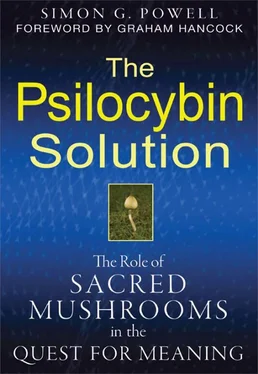It appears then that the Spanish clergy were ultimately unsuccessful in silencing the claims made by their subdued and conquered subjects; messages in stone speak far louder than words. Xochipilli provides rock-hard testimony for the Aztecs’ sacred bond with the natural environment and its array of potent botanical resources. What exactly the Aztecs experienced through psilocybin remains debatable, although we can be sure that their visions were vivid and convincing enough for them to regard the mushroom as a link to divine realms of being, no less than the manifestation of God’s Flesh on the Earth.
Wasson also went on to study pre-Conquest Aztec poetry written in the native Nahuatl language. When this poetry first became accessible to the West, it had been noted that “flowers” were referred to often. Peculiarly often in fact. Moreover, the oft-mentioned “flowers” were seldom, if ever, distinguished from one another. Like the statue of Xochipilli, Wasson realized that the “flowers” referred to visionary agents, most notably the psilocybin mushroom.
For instance, the poetry speaks of “the flowers that inebriate,” “the joyous flowers,” “the flowers without roots,” “the precious flowers,” and so on. Careful study shows that Nahuatl poetry is teeming with embellished references to “flowers.” This only makes sense if we accept that the Aztecs worshipped the mushroom and other psychedelic agents because of their transcendental psychological effects and set their praises to poetry. As in the sculpting of the “Prince of Flowers,” the Aztec poets who wrote of “flowers” were producing their art from direct experience, their works channeling their deific respect.
As a final testimony to the Aztecs’ use of psilocybin, mushroom motifs are also found in pre-Conquest codices (these codices are the pictorial records of the Aztecs themselves and not those made by Spanish historians), in particular within the pages of the Vienna Codex, a historical document rich in pictographic information, including a section on ancient myths, aptly named the “Origin of Things.” One page of this codex depicts the famous Mesoamerican god Quetzalcoatl being tutored in the use of mushrooms. There is no ambiguity in the depictions—an entire page clearly portrays ritual mushroom use.
Prior to the Aztecs’ rise to dominance and before the time of the Toltecs’ reign, the religious core of pre-Columbian Mesoamerica was the prosperous city of Teotihuacán, located in the Valley of Mexico, near modern-day Mexico City. The city dates from 150 B.C. to 750 A.D., but little is known about the Teotihuacáns, although Aztec legends equate this location with the birthplace of their deities. Its very name was given by the Aztecs who had discovered it six hundred years after its mysterious collapse and means “Place of the Gods” in Nahuatl.
Due to the immense scale of Teotihuacán’s religious architecture, which includes the spectacular Pyramids of the Sun and Moon and highly sophisticated wall paintings rife with ornate serpent motifs, it can be reasonably assumed that it was the center of an important religious cult. The overt presence of serpent motifs on the architecture is a strong indication of religious worship, since the pantheon of almost all Mesoamerican cultures includes mythical serpentine entities, such as the feathered serpent god Quetzalcoatl. Elaborately stylized serpents were used both to represent gods and to symbolize divine power penetrating the mundane world. Their fearsome presence on and around temples signified that the temple was a sacred place to be guarded from profane intrusion.
Of most concern here are the style and content of the numerous mural paintings that adorn most of Teotihuacán’s temples and shrines. In these murals we once more find depictions of various flowers, one of which is the morning glory (either Turbina corymbosa or Ipomoea violacea ). As stated, the seeds of this plant species contain LSD-related compounds known to have been used by the Aztecs for religious communion. It is therefore reasonable to assume that the templegoers at Teotihuacáan knew of, and thus utilized, the psychedelic effect of the morning glory.
Whether mushrooms are depicted in the temple murals is a somewhat contentious issue. While Wasson affirmed this and pointed out what he considered to be mushroom symbols, these same motifs have been identified by other Mesoamerican scholars as representing the water lily. Although various related African species of water lily are thought to be psychoactive, it has not been firmly established whether the New World variety are equally as potent. Either way, Wasson conjectured that the various temples of Teotihuacan, decorated as they are with depictions of psychedelic plants (the morning glory at least), were sacred sites where the ritual ingestion of entheogens took place.
Secret Psychedelic Legacies
The concept that indigenous visionary agents have been ritually consumed by ancient cultures in order to induce theophany and religious solidarity should come as no surprise. In ancient Greece the classic Eleusinian Mystery cult echoes the inferred scenario occurring at Teotihuacán. Mystery rites took place each year at Eleusis, near Athens, centered on the drinking of some secret potion that granted a transcendental vision to initiates. The entire sacred ceremony was held within the guarded confines of a hallowed temple. Recent theories have proposed that this Eleusinian drink was made from barley exposed to ergot. This would mean that it contained entheogenic substances because ergot, a tiny plant fungus that grows on wheat and barley, contains a number of LSD-related compounds. Although this psychedelic scenario has not been confirmed and remains merely an engaging hypothesis (ergot is also potentially toxic), the point is that the potion was almost certain to have contained some form of psychedelic alkaloid with the capacity to engender the type of mystical experience attested to in Greek historical literature. Wasson assumed that Teotihuacán was a Mesoamerican equivalent to Eleusis, that is, that both were sacred places where visionary agents were ritually administered.
Clearly the morning glory plant was utilized for its psychoactive effect by the Teotihuacáns (assuming of course that they did not just like the look of it), as the various murals testify, and it follows that psilocybin mushrooms would also have been ingested had their properties been known at the time.
The Birth of the Religious Impulse
Claims that infer that psychoactive plants and fungi played a major role in ancient religion might be considered to belittle religion in some way, as though one were reducing everything to “damnable drugs.” Nothing is further from the truth. Far from reducing the religion, the religion becomes firmly entwined with the unequivocal numinous effects of vision-inducing fungi and plant species. That is the strength and force of such environmental resources. Visionary plants and fungi cannot fail to have a dramatic impact. Anyone like Wasson who has made the sacred connection within his psyche through the action of natural entheogens knows of their profoundly spiritual impact.
Ultimately one comes to suspect, like Wasson, that the very historical source of humankind’s religious impulse lies in our ancestors’ primeval encounters with raw entheogenic species like the psilocybin mushroom, which are effective without the need for elaborate preparation. This scenario does not lessen religion; it empowers it, giving it an unstoppable impetus created through the effect of visionary alkaloids in opening up the boundless capacities of the human mind. God becomes connected to a state of consciousness, an inwardly felt presence mysteriously welling up from the depths of the psyche and not from some abstract dogma. However, religious dogma might well allude to the experience and indeed testify to the reality of entheogen-induced theophany. Yet once a detailed knowledge of the plant or fungus in question is lost in the hazy mists of time, then any lingering memory of its original entheogenic power will be no more than words, an echo of a once-living mystery.
Читать дальше










